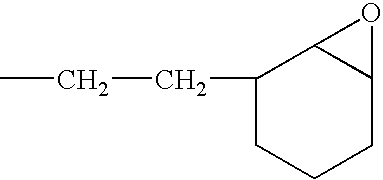Active Energy Ray-Curable, Organopolysiloxane Resin Composition, Light-Transmitting Component, And Method For Manufacturing The Light-Transmitting Component
- Summary
- Abstract
- Description
- Claims
- Application Information
AI Technical Summary
Benefits of technology
Problems solved by technology
Method used
Image
Examples
reference example 1
Preparation of Epoxy-Containing Organopolysiloxane Resin (A1)
[0058]A solution of a silanol-containing methylphenylpolysiloxane resin was prepared by co-hydrolyzing and condensing a mixture of 47 g of dimethyldichlorosilane, 505 g of phenyltrichlorosilane in a mixture of 500 g of toluene, 142 g of 2-propanol, and 142 g of water. The solution was neutralized with a saturated aqueous solution of sodium hydrogencarbonate, washed with water, and then water was completely removed by heating. The residual solution was combined with 226 g of 3,4-epoxycyclohexyl) ethyltrimethoxysilane and 2 g of a 50 wt % aqueous solution of potassium hydroxide, and then, while the solution was heated and stirred, the water, methanol, and toluene were removed by azeotropic dehydration. In this operation, an appropriate amount of toluene was added, and concentration of solids was maintained at about 50 wt %. Upon completion of the silanol dehydration condensation reaction, refluxing was continued for several ...
reference example 2
Preparation of Epoxy-Containing Organopolysiloxane Resin (A2)
[0059]A toluene solution (490 g of solids) of an epoxy-containing organopolysiloxane resin represented by the following average unit formula: [Me2SiO2 / 2]0.10 MeSiO3 / 2]0.30 [PhSiO3 / 2]0.35 [E3SiO3 / 2]0.25 was prepared by means of the same reaction as in Reference Example 1, with the exception that the starting material was composed of 315 g of phenyltrichlorosilane, 191 g of methyltrichlorosilane, 55 g of dimethyldichlorosilane, and 262 g of 2-(3,4-epoxycyclohexyl)ethyltrimethoxysilane. In obtained epoxy-containing organopolysiloxane resin, the number-average molecular weight was 3700, the content of the phenyl groups was 32 mole %, and the total content of the silanol groups and methoxy groups was 0.9 mole %. The toluene was removed by the method described in the subsequent practical examples.
reference example 3
Preparation of Epoxy-Containing Organopolysiloxane Resin (A3)
[0060]A toluene solution (490 g of solids) of an epoxy-containing organopolysiloxane resin represented by the following average unit formula: [Me2ViSiO1 / 2]0.10 [Me2SiO2 / 2]0.05 [PhSiO3 / 2]0.55 [E3SiO3 / 2]0.30 was prepared by means of the same reaction as in Reference Example 1, with the exception that the starting material was composed of 423 g of phenyltrichlorosilane, 23.5 g of dimethyldichlorosilane, 39.5 g of trimethoxychlorosilane, and 269 g of 2-(3,4-epoxycyclohexyl)ethyltrimethoxysilane. In the obtained epoxy-containing organopolysiloxane resin, the number-average molecular weight was 1700, the content of the phenyl groups was 44 mole %, and the total content of the silanol groups and methoxy groups was 0.6 mole %. The toluene was removed by the method described in subsequent practical examples.
PUM
| Property | Measurement | Unit |
|---|---|---|
| Time | aaaaa | aaaaa |
| Percent by mass | aaaaa | aaaaa |
| Percent by mass | aaaaa | aaaaa |
Abstract
Description
Claims
Application Information
 Login to View More
Login to View More - R&D
- Intellectual Property
- Life Sciences
- Materials
- Tech Scout
- Unparalleled Data Quality
- Higher Quality Content
- 60% Fewer Hallucinations
Browse by: Latest US Patents, China's latest patents, Technical Efficacy Thesaurus, Application Domain, Technology Topic, Popular Technical Reports.
© 2025 PatSnap. All rights reserved.Legal|Privacy policy|Modern Slavery Act Transparency Statement|Sitemap|About US| Contact US: help@patsnap.com



